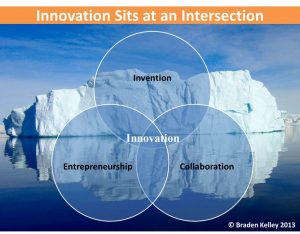For companies to achieve innovation success, a few factors are involved. These include inventing, collaborating, entrepreneurship, and the most important one- Curiosity.
In this guest post by Braden Kelly, you will get a clear understanding of these aspects.
Achieving innovation success is not easy. Sustaining innovation success is even harder. The list of innovative companies that no longer exist is long. Some of the biggest enemies of innovation are ultimately complacency and resistance to change and lack of innovation.
So what is the key to innovation success?
What lies beneath the artefacts of innovation success that we could point to in individuals or companies that we hold up as innovation heroes? What different factors do you need to enhance in your innovation management?
Well, as I tell the audiences of my keynotes, workshops, and masterclasses around the world, innovation success rises from the intersection of invention (which includes creativity), collaboration, and entrepreneurship.
I cover these topics on Human-Centered Change & Innovation.

Invention
Invention and creativity are incredibly important to innovation, but inventing is not innovation and creativity is not innovation.
These are but components of creating successful innovation. Teaching your employees new creativity tools like SCAMPER or SIT, engaging in brainstorming activities after teaching people how to brainstorm properly, or providing your employees with the space and time in their work lives to innovate will help you achieve greater innovation success, but they are not secret.
They are but one part.
Collaboration
Several people are travelling through the world of business and innovation literature spreading the myth that people are either innovative or they’re not, that people either possess the innovator’s DNA or they don’t.
I say “hogwash” (or sometimes something a little bit stronger). Innovation is a team sport and we all have a role to play. It is because of this belief that I created the Nine Innovation Roles and this framework for team-based innovation has resonated well with people all around the world.
As a result, the Nine Innovation Roles from my book Stoking Your Innovation Bonfire have already been translated into Spanish, French, and Swedish, with Dutch and Chinese translations on the way soon.
If you’re not familiar with the Nine Innovation Roles, they are:
- Revolutionary
- Artist
- Connector
- Magic Maker
- Customer Champion
- Judge
- Troubleshooter
- Conscript
- Evangelist
But understanding which of the Nine Innovation Roles you play on effective innovation teams is just the beginning.
At the same time, we must begin to train our employees in the basic principles that power collaboration and teach them how to become effective collaborators. But collaboration is also only one component.
Entrepreneurship
Other than leadership, no other topic probably occupies a greater percentage of the space for business books in an American bookstore than entrepreneurship.
This topic captivates the minds of people in the United States and many other countries, and everywhere you go cities, states, countries, universities, and private companies are setting up incubators or startup accelerators to encourage entrepreneurship and innovation.
This is important, but the importance of entrepreneurship is not limited only to the entrepreneur. At the same time, we must not forget to the continuing health of our organizations.
In some ways, intrapreneurship is MORE important to the innovation success of a country than entrepreneurship because collaborative, creative intrapreneurship is the flavour of entrepreneurship that keeps a country’s great companies alive (through this innovation intersection of course).
Entrepreneurs and intrapreneurs are both important and we must consciously try to grow both in a successful society. While intrapreneurs may not have the same tolerance for risk as an entrepreneur, they also need to understand how to make a business case and other core tenets of entrepreneurship.
The need to integrate and educate
I can state in no uncertain terms the importance for companies serious about innovation.
And yes, even countries or states or cities that are serious about innovation, to educate their people in the core knowledge, skills, and abilities that relate to invention, collaboration, and entrepreneurship.
Companies need to educate their employees. Governments AND parents need to collaborate in teaching their children. If you do this, your employees or your future citizens will have a much better chance of helping you achieve innovation success for your company or your society.
But even actively encouraging the intersection of invention, collaboration, entrepreneurship knowledge, skills, abilities, and practice is not enough.
The reason is that the power of this intersection does not represent the secret of innovation success. This intersection is central to sustained innovation success, but the secret lies elsewhere.
So what is the key to innovation success?
In one word?
The answer is… Curiosity
Curiosity:
Dictionary.com defines curiosity as “the desire to learn or know about anything; inquisitiveness.”
Merriam-Webster defines curiosity as the “Desire to know… Inquisitive interest in others’ concerns…Interest leading to inquiry “
The reason that curiosity is the secret to innovation success is that the absence of curiosity leads to acceptance and comfort in the status quo.
The absence of curiosity leads to complacency (one of the enemies of innovation) and when organizations (or societies) become complacent or comfortable, they usually get run over from behind.
When organizations or societies lack curiosity, they struggle to innovate. Curiosity causes people to ask ‘Why’ questions and ‘What if’ questions.
Curiosity leads to inspiration. Inspiration leads to insight. Insights lead to ideas.
In a company or society where invention, collaboration, and entrepreneurship knowledge, skills, abilities, and practice are encouraged, ideas lead to action.
Conclusion:
So, if you want to have innovation success in your company or your society, you must work to create an innovation culture that encourages curiosity instead of crushing it.
Unfortunately technology and the educational system in the United States and the rallying cry of “More STEM!” are having the unintended consequence of crushing creativity and creating a generation of trivia experts and linear thinkers for our society.
We, as parents and educators and managers, must as a result seek to undo some of this damage. If you haven’t already read it, I encourage you to check out my article ‘Stop Praying for Education Reform‘.
We must find ways to reawaken the curiosity of our employees, to keep them curious, and to keep the curiosity of our children alive.
We must find a way to fight against the tyranny of linear thinking and the ‘right’ answer, and instead, inspire our children to continue asking ‘why’ – even though sometimes it can be annoying.
To close I will leave you with a bastardized quote from the most interesting man in the world:
“Stay curious my friend.”
About the author:

Braden Kelley is a Human-Centered Experience, Innovation and Transformation consultant at HCL Technologies. He is a popular innovation speaker and creator of the FutureHacking™ and Human-Centered Change™ methodologies.
He is the author of Stoking Your Innovation Bonfire from John Wiley & Sons and Charting Change from Palgrave Macmillan. Braden is a US Navy veteran and earned his MBA from the top-rated London Business School.
Also read: Capture employee ideas in the 11-step plan.




